|
|
|
Spanish Heralds
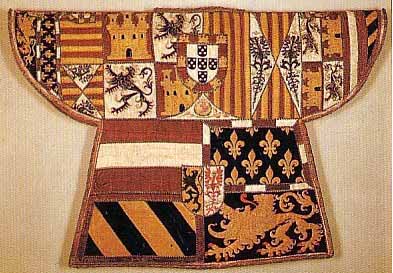
Tabard from the reign of Philip II (Vienna, Kunsthistorische Museum)
Many of the characteristics of early Iberian heraldry were shaped by the centuries of warfare known as the reconquista. The presence and activity of the great military-monastic orders, such as those of Santiago, Calatrava and Alcántara in reconquering and eventually unifying the whole peninsula and the chivalric ideals which they represented must have facilitated the development and use of heraldic symbols in the late twelfth century.
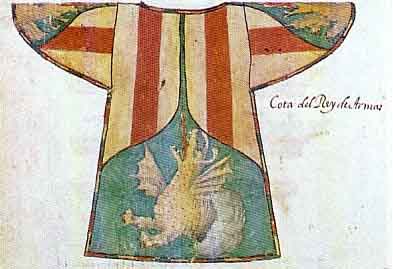
Drawing of a tabard of the arms of the Duke of Alburquerque
(16th cent. Madrid, Real Academia de la Historia)
The nature of continual border conflict between the Moorish and Christian kingdoms of medieval Iberia helped to distinguish a certain sense of ethnic identity, or limpieza de sangre, and heraldry was just one outlet for this form of national expression. Attempts were made to make arms distinctive of class as well as ethnicity, and the Castillian sovereigns restricted arms to members of the nobility by virtue of Law 64 of the 1583 Cortes de Tudela and was again reiterated by Law 13 of the 1642 Cortes [1].

Navarra King of Arms
Spanish persevantes, heraldos or farautes and reyes de armas were appointed directly by their sovereign; the junior officers had to be at least twenty years old and be nominated by two heraldos. Persevantes were made by the sovereign during a ceremony where the king baptized the young man with water and wine, and after at least seven years they could be promoted with the blessings of two reyes de armas and four heraldos. New heraldos and reyes de armas had to take an oath of office and the latter were appointed only with the consent of every officer of arms.
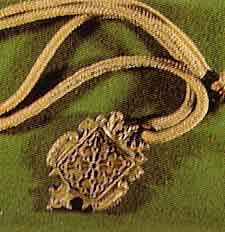
Insignia of the Navarra King of Arms
(16th cent. Pamplona, Archivo General de Navarra)
Heraldos were usually named after provinces and non-capital cities, while while reyes de armas were named after the Spanish kingdoms. Officers of arms were were known variously as España, Castilla, León, Frechas, Sevilla, Córdoba, Murcia, Granada (created in 1496 to honor the reunification of Spain), Bethune, Estella, Viana, Libertat, Blanc Lévrier, Bonne Foy, Las, Gounzcuant, Lamas, Navarra, Cataluña, Sicilia, Aragón, Nápoles, Toledo (bearing Azure an imperial crown or), Valencia and Mallorca [2]. While these appointments were not hereditary, at least fifteen Spanish families produced more than one herald each in the past five hundred years (compared to about the same number for England, Scotland and Ireland collectively) [3].

Uniform of a Spanish King of Arms
(1759, Madrid, Archivo General de Palacio)
While the certification of coats of arms comprised the majority of the Spanish heralds’ armorial activites, the all served many of the ordinary functions of other European heralds, namely acting as emissaries, experts in ceremony and judges at tournaments. Spanish heralds served in both palatine and private capacities, the former including diplomatic and ceremonial rôles.


Formal uniform of a Spanish King of Arms until 1830
(Madrid, Archivo General de Palacio)
The seventeenth century even saw the heralds engaged in Vistas de Armas, or visitations to the provinces of Spain to locate, inspect and correct heraldic irregularities. Their regulatory powers were such that no Royal officials could interfere in their tours but the Supremo y Real Consejo de Castilla, and in 1649 the irregular use of armorial bearings in the Cathedral of Los Angeles, Diocese of Tlaxcala, Nueve España, brought about the castigation of the Archbishop of México [4].


Informal uniform of a Spanish King of Arms until 1830
(Madrid, Archivo General de Palacio)
These public duties continued until a Royal Order of February 12, 1846 de-activated and removed heralds from their everyday duties at the palace [5]. By this time, heralds were organized into a Corps of Chronicler Kings of Arms consisting of four officers and two supernumeraries headed by a dean. As they were never incorporated into a collegiate system comparable to those which developed in England, Scotland and France, heralds and kings of arms were relatively weak until they were reformed in the early twentieth century [6]. The corps was a part of the royal household and responsible to the Master of the Kings Horse [7].
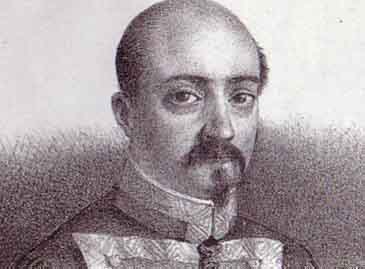
King of Arms Luis Villar y Pascual (1858, Madrid, private collection)
The cronistas de armas served at the openings of the Cortes and their jurisdiction excepted only Granada and Navarre (where reyes de armas were appointed by provincial councils). The cronistas were a colorful lot and included Segundo de Sarrión y Díaz de Herrera (who was arrested at the request of the Brazilian Ambassador because of his revolutionary activities in Cumaní region), Jose Gonzalo Lavin del Noval (the noted psuedoscientist who would go on to become Juez de Armas of the self-styled Military and Hospitaller Order of Saint Lazarus of Jerusalem), Luis Rubio y Ganga (who got in trouble for an irregular 1928 armorial certification issued to a foreigner then in state custody), Juan Felix de Rujula y Vaca (whose death in 1978 extinguished the last living link to the abolished Corp), Luis Vilar y Vilar (whose irregular certification of arms of a foreign French citizen in 1913 led to the 1915 reforms) and Julio de Yepes y Rosales (who began his heraldic writings at the tender age of twelve!) [8].
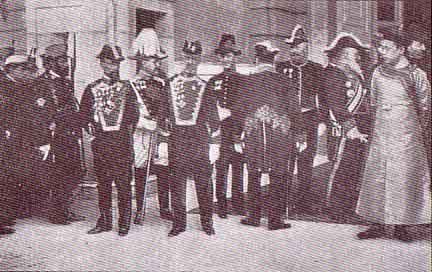
Kings of Arms Felix and Jose de Rujula
(1900, Madrid, private collection)
Luis Vilar’s irregular certification prompted a Royal Decree of 1915 which reformed the practice of appointing heralds. Henceforth, to be appointed heralds must possess a degree in law or philosophy and be examined by a board of historians, notaries and archivists, while their armorial certificates would only be valid if authorized by the Ministry of Grace and Justice [9]. With the establishment of la Segunda Republica, the CKA was effectively abolished.
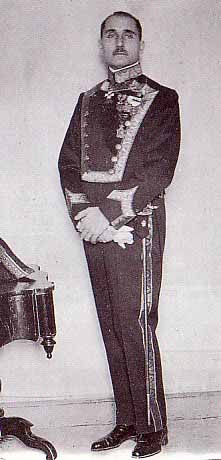
King of Arms Gonzalo Lavin (1925, Madrid, private collection)
A Ministerial Order of 16 May 1931 left the Chroniclers with positions and pensions. The five remaining members (Jose de Rujula y Ochotorena, Luis Rubio y Ganga, Juan Felix de Rujula y Vaca, Jose Gonzalo Lavin del Noval and Julio de Yepes y Rosales) were reduced to private genealogists and their palace functions ceased. Despite these hardships, their fidelity to the Crown persisted. During the Spanish Civil War (1936-1939), the archives of the CKA (which was in the hands of then Dean Jose de Rujula y Ochotorena) were confiscated by and deposited in the Biblioteca Nacional.

Chronicler of Arms of Castile and Leon,
Alfonso de Ceballos-Escalera y Gila, Marques de La Floresta
Following the Spanish Civil War, Generalissimo Franco, Head of State, grateful for the support that he received from the majority of the nobility allowed the Council of the Grandeza (Council of the Nobility) to resume its activities, and the noble corporations and military orders were also allowed to function normally. Following the 1947 referendum which resulted in Spain returning to a quasi-monarchal system, the government passed a law which restored the nobiliary legislation abolished by the Republicans in 1931. While this law only referred specifically to noble titles, it applied to all nobiliary aspects including the operations of the CKA. However, due to the absence of a Court, political circumstances required the modification of the legal texts that applied these CKAs.
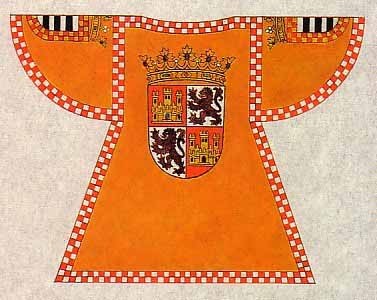
Drawing of a tabard of the Chronicler of Arms of Castile and Leon
personalized with the arms of the Marques de La Floresta
In 1951, in application of the 13 April Decree of the Ministry of Justice, the government reformed the status and functions of the Spanish officers of arms so as to guarantee the delicate mission of these professionals, modernize their functions and to protect the interests of those who apply to them [10]. The five articles of the Decree regulated their performance as that of any other liberal profession, that is to say that they were to be remunerated for their services, thus putting an end to their status as Court functionaries or public servants.
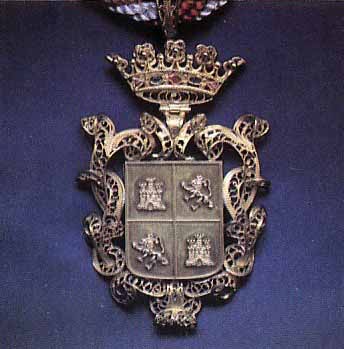
Insignia of the Chronicler of Arms of Castile and Leon (1991)
On the other hand, official recognition of their certificates of genealogy, nobility and arms so long as they included the approval of the Ministry of Justice was maintained. Thus, the abolished Corp of Chronicler Kings of Arms was not reestablished and the officers of arms were henceforth to be known as plain Chroniclers of Arms as the word King did not sit well with the government of the time. They were also solely responsible before the law for the certificates which they issued. The remaining cronistas (Jose de Rujula y Ochotorena, Juan Felix de Rujula y Vaca, Jose Gonzalo Lavin del Noval and Julio de Yepes y Rosales) applied to the Ministry of Justice to have their status confirmed and their rights were recognized in March of 1953 [11].
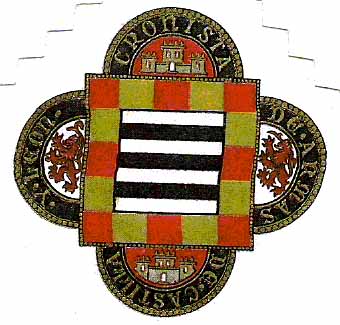
Seal of the Chronicler of Arms of Castile and Leon
Citizens of South American republics and other countries once claimed by the Crown of Spain, and descendants of Spanish citizens have the same rights as Spaniards with respect to this legislation. Currently there are two cronistas officially accredited by the Ministry of Justice. The most senior, although there is some question as to the legality of his appointment is Don Vicente de Cadenas y Vicent [12] who was so appointed by Generalissimo Franco in 1951 although he lacked the required academic degrees, did not sit for the required examinations and was not confirmed in his functions by the publication of his appointment in the Official Bulletin [13]. Even so, his certificates are approved by the Ministry of Justice and are accepted as legally valid. The most recently appointed herald is the Chronicle of Arms of Castile and Leon, Don Alfonso Ceballos-Escalera y Gila, Marques de La Floresta [14]. A lawyer by profession, he was appointed in 1992 in accordance with these various regulations.
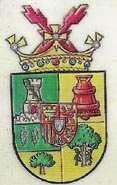
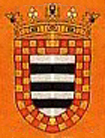
Arms of (left) the Chronicler King of Arms of Spain, Don Vicente de Cadenas y Vicent
(with an escutcheon of the Royal Arms and coronet of a cronista rey de armas)
and (right) the Chronicler of Arms of Castile and Leon
click here to sign my guestbook
click here to view my guestbook
by
Notes
[1] A de Ceballos-Escalera y Gila, Heraldos y Reyes de Armas en la Corte de España, Madrid, 1993. p. 427.
[2] R. D. Casas, Arte y Etiqueta de los Reyes Catolicos, Madrid, 1993.
[3] The office of Chronicler King of Arms was very much a family affair. Families which produced more than one King of Arms from the sixteenth to the twentieth centuries were numerous (see Ceballos-Escalera y Gila, op.cit.): Alfonso de Guerra (three Chroniclers), Brochero (two), Cueva (two), Gomez de Arevalo, (two), Heredia (two), Losas (two), Martinez, (two), Medina (two), Rua (two), Rubio (two), Rujula (six), Sotomayor (two), Urbina (two), Vilar (three) and Zazo (six). There were instances of multiple heralds in a single family in other parts of Europe, as well. In England, families which produced more than one Garter King of Arms were Wrythe (two), Dethick (two), St George (three), Anstis (two), Bigland (two) and Woods (three). Families which produced more than one Clarenceux King of Arms were St George (two) and Bigland (two). Families which produced more than one Norroy King of Arms were St George (4), Le Neve (2) and Dugdale (2). In Scotland, families which produced more than one Lord Lyon King of Arms were Lindsay (3), Campbell (2) and Innes (2) (see Woodcock and Robinson, The Oxford Guide to Heraldry, Oxford University Press, Oxford, 1990, pp.192-196). In Ireland, families which produced more than one Ulster King of Arms were Ussher (two), Hawkins (two) and Fortescue (two).
[4] J. A. de Guerra Y Villegas, Discurso Histórico Político Sobre el Origen y Preheminencias de el Oficio de Heraldos, Reyes de Armas, Feciales y Caduceadores, Madrid, 1693.
[5] See Ceballos-Escalera y Gila, p. 180.
[6] "...the heralds themselves seem to have been thought of little acount. Indeed, even the post of kings of arms were of but small moment, and the certificates the officers issued carried little legal weight. In the twentieth century things improved somewhat" (see Stephen Friar, ed., A New Dictionary of Heraldry C Black, London, 1987, p.322).
[7] Ibid., pp. 364-378.
[8] Ibid., pp. 252-268.
[9] "Real Decreto de 29 de julio de 1915. Graceta de Mardid, n. 212, del 31 de julio de 1915. Esposición. Señor: Los Cronistas de Armas de V.M., además de la función palatina que les está encomendada, vienen de muy antiguo expidiendo certificaciones en materia de nobleza, genealogía y escudos de armas, por haberles reconocido esta facultad varias disposiciones emanadas de la autoridad Real, con anterioridad a la implanación del sistema constitucional hoy vigente en España; pero anuladas y sin vigor las aludidas disposiciones se hace preciso, para que tengan validez las certificaciones que expidan los Reyes de Armas, dictar otras nuevas, que son: la de exigir que los mencionados Cronistas prueben su aptitud ante un Tribunal competente y obtengan, previo pago de los derechos correpondientes, un albalá que les autorice para ejercer su cargo. Será además requisito indispensable que estas certificaciones vayan autorizadas por el Ministerio de Gracia y Justicia. Tal es el objecto del adjunto proyecto de Decreto que el Ministro que subscribe tiene el honor de someter a la aprobación de V.M. Madrid, 29 de julio de 1915. Señor: A.L.R.P. de V.M.: Manuel de Burgos y Mazo. Real Decreto. A propuesta del Ministro de Gracia y Justicia, y de acuerdo con el parecer de Mi Consejo de Ministros, Vengo en decretar lo siguiente: Artículo 1) Tendrán validez las certificaciones que los Reyes de Armas declarados aptos con arreglo a las prescripciones de este Decreto expidan en materia de nobleza, genealogía y escudos de armas, siempre que vayan autorizadas por el Ministerio de Gracia y Justicia. Artículo 2) Los Reyes de Armas actuales, y los que en lo sucesivo obtengan estos nombramientos, probarán su aptitud para expedir las certificaciones de que se habla en articulo anterior ante un Tribunal presidido por el Subsecretario del Ministerio de Gracia y Justicia y constituido en concepto de Vocales por un individuo de número de la Real Academia de la Historia, por un notario de reconocida competencia en la materia, nombrados todos ellos por el Ministerio de Gracia y Justicia. Los Vocales que figuran en los tres primeros lugares serán propuestos, respectivamente, por la Real Academia de la Historia, por la Junta de Gobierno del Colegio Notarial y por el Tribunal un Oficial del Cuerpo Técnico de la Subsecretaria del Ministerio de Gracia y Justicia, que con voz y voto desempañará las funciones de secretario. Este Tribunal formará el Cuestionario y determinará todo lo relativo al examen de aptitud. Articulo 3) Una vez declarada la aptitud de los Reyes de Armas para expedir certificaciones nobiliarias, obtendrá, previo el pago de los derechos correpondientes, un albalá en forma igual a la de los Monteros de Cámara. Artículo 4) Los Reyes de Armas serán personalmente responsables de las certificaciones que expidan en el ejercicio de sus cargos. Dado en Palacio a veintinueve de julio de mil novecientos quince. =ALFONSO= El Ministro de Gracia y Justicia, Manuel de Burgos y Mazo" (see Ceballos-Escalera y Gila, op cit., pp. 360-361).
[10] "Decreto de 13 de abril de 1951. n. 123, del 3 de mayo de 1951. Decreto de 13 de abril de 1951 por el que se regulan las funciones que los Cronistas Reyes de Armas han venido, tanto por costumbre como por Ley, desempenando, entre otras funciones, las de expedir certificaciones de armas, genealogias y nobleza. Estas funciones fueron reguladas por la Real Orden de diecisiete de noviembre de mil setecientos cuarenta y siete (Novisima Recopilacion, Libro XI, Titulo XXVII, Ley primera), y posteriormente por el Real Decreto de veintinueve de julio de mil novecientos quince. El aumento de peticiones de rehabilitacion y sucesion a partir de mil novecientos cuarenta y ocho, como consecuencia del restablecimiento de la legislacion nobiliaria, suspendida desde mil novecientos treinta y uno hasta dicha fecha, ha motivado que personas sin Titulo de aptitud desmpenen las funciones encomendadas a los referidos Cronistas. A fin de dotar de suficientes garantias la delicada mision de estos profesionales, actualizar sus funciones y proteger adecuadamente los intereses de los que a ellos acuden, a propuesta del Ministro de Justicia y previa deliberacion del Consejo de Ministros. Dispongo: Articulo primero. El Titulo de Cronista de Armas se obtendra previo examen de aptitud entre Licenciados en Derecho o Filosofia y Letras, mayors de veintiun anos. La Convocatoria se hare por Orden, en la que figuraran las condiciones y requisitos que deben cumplir los aspirantes. Articulo segundo. El examen se verificara ante un Tribunal presidio por el Subsecretarion de Justicia y constituido, en concepto de Vocales, por un Academico de numero de la Real de la Historia, un Notario del Ilstre Colegio de Madrid, un funcionario del Cuerpo de Archivos, un Cronista de Armas en ejercicio y el Letrado jefe de la Seccion de Titulos del Ministerio, que, con voz y voto, desempenaralas funciones de Secretario. Los Vocales que figuran en los dos primeros lugares seranpropuestos, respectivamente, por la Real Academia de la Historia y por el Ministerio de Educacion Nacional, y todo, designados por Orden ministerial. Articulo tercero. El nombramiento se hara por Orden ministerial, y previo pago de los derechos correspondientes les sera expedido un Titulo por el Ministerio de Justicia sin el cual no podran ejercer sus funciones. Articulo cuarto. Compete a los Cronistas de Armas la expedicion de certificaciones de nobleza, genealogia y escudos de armas. Las certificaiones de los Cronistas de Armas con autorizacion para el uso solo tendran validez con el visto bueno del Ministerio de Justicia. Los Cronistas de Armas seran personalmente responsables de las certificaciones que expidan en el ejercicio de sus cargos. Articulo quinto. Se autoriza al Ministerio de Justicia para dictar cuantas disposiciones aclaratorias y complementarias requiera la ejecucion del presente Decreto. Dispisicion transitoria. Los actuales Cronistas Reyes de Armas Presentaran dentro del plazo de un mes, contando a partir de la publicacion de este Decreto, sus respectivos Albalas o nombramientos en el Ministerio de Justicia para la correspondiente anotcion constancia de antiguedad y toma de razon sin cuyo requisito quedaran dichos Titulos sin validez alguna. Asi lo dispongo por el presente Decreto, dado en Madrid a trece de abril de mil novecientos cincuenta y uno. =FRANCISCO FRANCO=. El Ministerio de Justicia, Raimundo Fernandez-Cuesta y Merelo.” (see Ceballos-Escalera y Gils, op.cit., pp. 362-363).
[11] Ibid., p 212.
[12] Ilustrisimo Senor Don Vicent de Cadenas y Vicent, de Gaztanaga y Nogues, Cronista Rey de Armas, Decano del Cuerpo, Knight of the Illustrious Order of Saint Januarius, founder of such publications as ‘Hidalguia,’ the Instituto Internacional de Heraldica y Genealogia, and the Asociascion de Hidalgos a Fuero de Espana, etc. (see Ceballos-Escalera y Gila, op.cit. p. 213). He adopted the title of Dean of the Corps of the Chronicler King of Arms in 1978 with the death of the last pre-republican King of Arms, despite the fact that the Corps was legally abolished by the Ministerial Order of 16 May 1931. Before being appointed Cronista de Armas in 1951, Cadenas y Vicent was a falangista and was the King of Arms of the Archduke Charles of Austria-Tuscany (Carlos VIII) the Carlist pretender to the Spanish Throne from 1943-1953) whom he met in Italy.
[13] Ibid., op.cit. p. 213.
[14] The Marques de La Floresta is also is a Knight of Grace and Devotion of the Sovereign Military Hospitaller Order of Saint John of Jerusalem of Rhodes and of Malta and a Conseiller Heraldique du Grand Magistere.